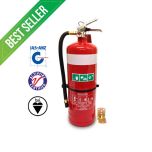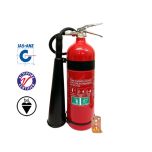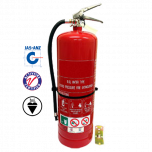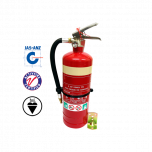Safe Operating of a fire extinguisher:
Knowing how to operate a fire extinguisher could save your life in an emergency. The key to putting out a fire with an extinguisher is to use the
PASS strategy:
- Pull the pin
- Aim the hose
- Squeeze the lever
- Sweep the hose
However, before you use a fire extinguisher to put out a fire, it's very important that you determine whether or not it's appropriate for you to be fighting the fire, and whether or not you'll be able to put it out. If you don't think you can fight the fire, or if you have any doubts, evacuate the building immediately and call the fire department.
Fires double in size every 60 seconds, so you don't want to be fumbling around in an emergency situation, reading over the instruction manual as a small flame on the stove grows into an inferno.
Remember, in an Emergency Call Triple Zero (000)
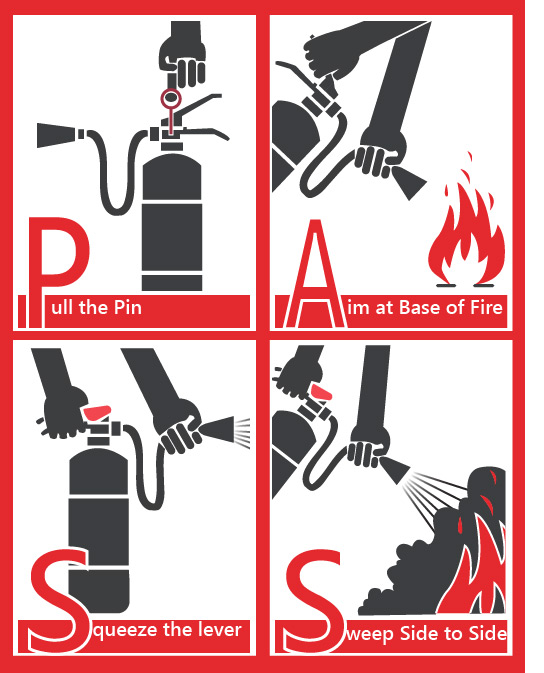
How to use an extinguisher video:
Reacting to a fire
Use a fire extinguisher for small, contained fires only.
Fire extinguishers are not meant to fight large or growing fires. Only attempt to fight a fire if the flames are shorter than you, and if the flames are contained in a small space. Evacuate immediately if the flames are taller than you, or if the fire is spreading and growing
1 - Instruct someone to call the fire department (Triple Zero 000) or call them yourself. Evacuate everybody from the building. Tell somebody to call the fire department or emergency services once that person is safely outside. Even if you're able to extinguish the fire on your own, it's best to have the fire department on the way in case something happens.
2 - Stand with your back to an exit. Before you use a fire extinguisher to put out a fire, it's important to take a couple safety precautions. Locate the nearest exit, and position yourself so your back is toward the exit. It will make it easy for you to escape if you have to leave quickly in an emergency.
3 - Move to the proper distance. Many fire extinguishers have a range of between 2.4 to 3.7 m. Before discharging the extinguisher, move toward or away from the fire so you're standing 1.8 to 2.4 m away.
4 - Pull the pin. Pull pin at the top of the extinguisher, breaking the seal. When in place, the pin keeps the handle from being pressed and accidentally operating the extinguisher. Immediately test the extinguisher.
5 - Aim. Approach the fire standing at a safe distance. Aim the nozzle or outlet towards the base of the fire.
6 - Squeeze. Squeeze the handles together to discharge the extinguishing agent inside. To stop discharge, release the handles.
7 - Sweep. Sweep the nozzle from side to side as you approach the fire, directing the extinguishing agent at the base of the flames. After an A Class fire is extinguished, probe for smouldering hot spots that could reignite the fuel.
8 - Leave immediately if you're unable to extinguish the fire. The average extinguisher will have enough agent inside to go for about 10 seconds. Back away and leave immediately if the fire isn't out when the extinguisher is fully discharged.
Below is a summary of the classes of fire, and a quick list showing which types of extinguisher should be used on each. We then provide a detailed explanation of each type of fire extinguisher below.
The classes of fire
There are six classes of fire: Class A, Class B, Class C, Class D, ‘Electrical’, and Class F.
– Class A fires – combustible materials: caused by flammable solids, such as wood, paper, and fabric
– Class B fires – flammable liquids: such as petrol, turpentine or paint
– Class C fires – flammable gases: like hydrogen, butane or methane
– Class D fires – combustible metals: chemicals such as magnesium, aluminum or potassium
– Electrical fires – electrical equipment: once the electrical item is removed, the fire changes class
– Class F fires – cooking oils: typically a chip-pan fire
Water Extinguisher
Water Fire extinguishers are for Class A fires only - they should not be used on Class B or E fires. The discharge stream could spread the flammable liquid in a Class B fire or could create a shock hazard on a Class E fire.
A Water extinguisher is identified by its all red cylinder and red band that runs around the top of the tank.
Dry Chemical Powder Extinguisher
Dry Chemical Powder fire extinguishers extinguish the fire primarily by interrupting the chemical reaction of the fire triangle.
They are effective on Class A, B, and E fires. They contain a chemical powder called monoammonium phosphate which extinguishes the fire when it spreads and melts over the flames. This agent also works by creating a barrier between the oxygen element and the fuel element on Class A fires.
A dry chemical fire extinguisher is identified by its all red cylinder and white band that runs around the top of the tank.
BE dry chemical is for Class B & E fires only. It is important to use the correct extinguisher for the type of fuel! Using the incorrect agent can allow the fire to re-ignite after apparently being extinguished succesfully.
Carbon Dioxide Extinguisher
Carbon Dioxide fire extinguishers extinguish fire by taking away the oxygen element of the fire triangle and also be removing the heat with a very cold discharge.
CO2 fire extinguishers contain a non-conductive and non-corrosive extinguishing agent therefore will cause no damage to electrical equipment which make it perfect for areas such as electrical switch rooms, server/data rooms, electrical machinery and offices..
Carbon dioxide can be used on Class B & E fires. They are usually ineffective on Class A fires.
A CO2 extinguisher is identified by its all red cylinder and black band that runs around the top of the tank.
Foam Extinguisher
Foam fire extinguishers work by forming a layer over the top of the burning substance which stops the fire by cutting off access to oxygen. Foam extinguishers are effective to combat Class B fires. They can also be used for Class A fires which include wood, plastic, textiles, and paper.
Foam fire extinguishers are generally used within warehouse’s, petrol stations and storage facilities and are not recommended for use on class F fires (cooking oils and fats).
A Foam fire extinguisher is identified by its all red cylinder and blue band that runs around the top of the tank.
Wet Chemical Extinguisher
Wet Chemical Extinguishers contain a solution of potassium, this solution smothers the fire and removes the element of heat. It prevents re-ignition by creating a barrier between the oxygen and fuel elements.
Wet chemical Class F extinguishers were developed for modern, high efficiency deep fat fryers in commercial cooking operations. They may also be used on Class A fires in commercial kitchens.
A Wet chemical fire extinguisher is identified by its all red cylinder and yellow band that runs around the top of the tank.

